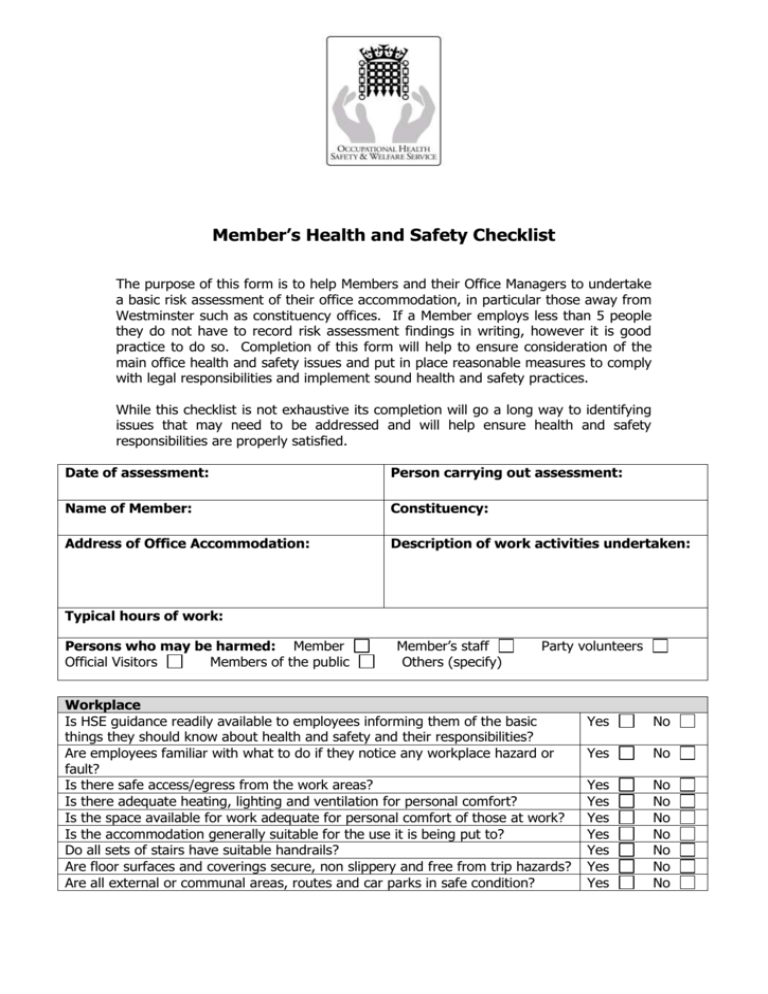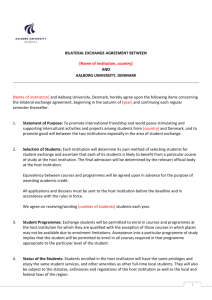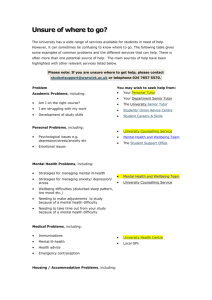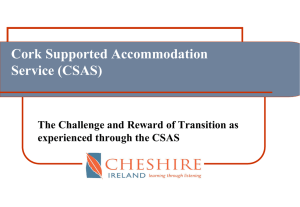Member`s Office Risk Assessment Checklist
advertisement

Member’s Health and Safety Checklist The purpose of this form is to help Members and their Office Managers to undertake a basic risk assessment of their office accommodation, in particular those away from Westminster such as constituency offices. If a Member employs less than 5 people they do not have to record risk assessment findings in writing, however it is good practice to do so. Completion of this form will help to ensure consideration of the main office health and safety issues and put in place reasonable measures to comply with legal responsibilities and implement sound health and safety practices. While this checklist is not exhaustive its completion will go a long way to identifying issues that may need to be addressed and will help ensure health and safety responsibilities are properly satisfied. Date of assessment: Person carrying out assessment: Name of Member: Constituency: Address of Office Accommodation: Description of work activities undertaken: Typical hours of work: Persons who may be harmed: Member Official Visitors Members of the public Member’s staff Others (specify) Party volunteers Workplace Is HSE guidance readily available to employees informing them of the basic things they should know about health and safety and their responsibilities? Are employees familiar with what to do if they notice any workplace hazard or fault? Is there safe access/egress from the work areas? Is there adequate heating, lighting and ventilation for personal comfort? Is the space available for work adequate for personal comfort of those at work? Is the accommodation generally suitable for the use it is being put to? Do all sets of stairs have suitable handrails? Are floor surfaces and coverings secure, non slippery and free from trip hazards? Are all external or communal areas, routes and car parks in safe condition? Yes No Yes No Yes Yes Yes Yes Yes Yes Yes No No No No No No No Disability Is your accommodation accessible and inclusive for people with disabilities, e.g. mobility or vision impairment. If you employ anybody with a disability have you discussed their needs with them and made any necessary reasonable adjustments? Welfare and Hygiene Are adequate numbers of waste bins provided and emptied regularly? Are properly ventilated toilet facilities available? Are washing facilities available with hot and cold running water? Is drinking water readily available? Are rest facilities available that are also suitable for employees to eat meals? Are office and communal areas kept in a clean condition, e.g. floors, furniture, toilets, hallways, etc.? Is there provision to store wet outdoor clothes (e.g. coats) to dry off, such as coat hooks or coat stand? Display screen equipment (computers) Have all employees using computers been provided with a suitable work surface and computer chair (i.e. 5-star base with back, height and seat adjustability)? Have separate screen, keyboard and mouse been provided? Have display screen equipment risk assessments been carried out? Have regular computer users been provided with user awareness training? Are computer users able to take regular breaks (e.g. 10 minutes per hour) away from working on the computer? Are computer users aware of their right to periodic eye tests? Portable electrical appliances Are all portable electrical appliances in good condition, suitable for use and maintained in accordance with manufacturer’s instructions? Are employees trained to use the equipment properly? Is equipment inspected and, if appropriate, tested regularly by a competent person? Are cables in good condition and located so as not to cause a trip hazard? Fire safety Are all fire escape routes and exits maintained clear of obstructions? Are flammable materials (e.g. paper) stored away from potential sources of ignition? Are housekeeping arrangements such that the accommodation is tidy, waste is kept to a minimum and there are appropriate storage arrangements for flammable equipment and paperwork. Are smoke detection arrangements in place, e.g. smoke or heat detectors, and if so are they regularly checked to ensure they are operable? Is the accommodation non smoking? Is adequate fire fighting equipment in place (e.g. CO2 extinguisher serviced annually) and have staff been instructed in its safe use? Is there a fire action notice clearly displayed? Are all employees familiar with the fire evacuation procedures? Yes No Yes No Yes Yes Yes Yes Yes Yes No No No No No No Yes No Yes No Yes Yes Yes Yes No No No No Yes No Yes No Yes Yes No No Yes No Yes Yes No No Yes No Yes No Yes Yes No No Yes Yes No No First Aid Is an employee nominated and trained as the appointed person to oversee first aid arrangements? Is an adequate first aid box available for use? Are employees aware of the procedure to follow in case of medical emergency? Manual Handling If employees carry out manual handling (e.g. movement of boxes of photocopier paper or heavy water bottles) are safe ways of working in place (e.g. by use of a trolley or breaking down the size of load)? Are employees aware of the right techniques to lift and move things? Accident Reporting Do you have an accident reporting book? Are employees familiar with the need to report accidents? Do you actively investigate any injury accident, fire or near miss incident? Hazardous Substances Are there any hazardous substances in use? Are employees familiar with safe use of hazardous substances, how to safely store them and how to dispose of them safely? Security Have you contacted your local police force in order to obtain a security assessment and advice on appropriate physical security measures required? Do you have appropriate procedures in place for when a person is working alone (e.g. mobile phones and calling in)? Have employees been instructed in how to deal with difficult/ violent situations? Are there known procedures for handling suspicious packages or other threats? Are there adequate measures in place to control unauthorised access to working areas (e.g. reception facilities, controlled entry system, CCTV, etc.)? Employee Wellbeing Are staff adequately skilled and trained to perform their regular duties? Are workloads regularly reviewed to ensure employees are not overburdened? Are employee working hours discussed and agreed as reasonable, including lunch and rest periods? Are timescales and deadlines for tasks or projects discussed to ensure they are realistic? Are resources and assistance adequate for tasks and projects to be achievable? Are employee responsibilities and decision-making authorities clear? Is openness and discussion encouraged if an employee feels stressed, shows signs of stress (e.g. mood swings or frequent bouts of illness), feels unwell or has symptoms of work related ill health (e.g. back pain or upper limb pain)? Vulnerable Employees (applicable only if you have vulnerable employees at work) If you have a work experience student working for you have you conducted a relevant risk assessment and implemented identified action? If you have a new or expectant mother working for you have you conducted a relevant risk assessment and implemented identified actions? Yes No Yes Yes No No Yes No Yes No Yes Yes Yes No No No Yes Yes No No Yes No Yes No Yes Yes Yes No No No Yes Yes Yes No No No Yes No Yes Yes Yes No No No Yes No Yes No Where an answer of ‘No’ is given to any question there may be a need for action. List any identified actions you intend to take in the table below, allocating responsibility and giving a realistic deadline. Prioritise, based on the level of risk, so that higher risks are dealt with first. Some guidance on what to do to properly manage the issues raised within this checklist is given in the section below the Scheduled of Actions. Further advice and guidance may be sought from Parliament’s Health and Safety Adviser on 020 7219 1505 or the Fire Safety Manager on 020 7219 4714. Schedule of Actions Action Person Responsible Deadline Guidance for Members to satisfy their health and safety responsibilities This guidance is not exhaustive, but will give the general standards Members and their staff should be working to in terms of health and safety management of their offices. It is broken down into similar sections to the risk assessment checklist. Workplace 1. If not the owner occupier you need to liaise with the landlord, other tenants, etc. to ensure that emergency procedures, building maintenance, condition of communal areas, security arrangements, etc. are to standards to your satisfaction and that the activities of other building users are not putting your employees at unacceptable risk. Also ensure all employees fully understand any building-wide procedures (e.g. fault reporting, evacuation and security). 2. Ensure the Health and Safety Executive poster ‘Health and Safety Law – what you should know’ is displayed or staff are given individual copies of the equivalent leaflet (free download at http://www.hse.gov.uk/pubns/law.pdf). 3. The accommodation should have clear, unobstructed routes to safely enter, move around and leave by, including an alternative route of escape in most cases. This means no storage or equipment on movement routes, no trip hazards, no slippery floors, no hazards at head height, etc. In the event of emergency all occupants should be able to leave quickly and easily without being exposed to risk. Where risks, such as limited headroom or change in floor (i.e. step or ramp) exist they should be clearly marked by hazard warning or signage. 4. All stairways should be in good condition with suitable handrails. 5. Temperature should be comfortable so that staff are able to work productively. This is normally between 19 to 25 degrees centigrade and should not be below 16 degrees centigrade. Measures such as safe heating systems, insulation of pipes, blinds for windows should be taken. Siting of workstations as regards position of radiators or in direct sunlight should be considered. A thermometer should be provided. 6. In warm weather conditions arrangements should be made to enable staff to keep cool – ideally air cooling/conditioning (though not always feasible), but in any case use of fans, opening of windows, supply of cold drinking water, relaxed dress code, etc can help improve comfort levels. Please note there is no stipulated maximum temperature for working, though reasonable steps to improve conditions should be taken. 7. The office should have reasonable circulation of air and ventilation to ensure good quality fresh air is in place. This can be achieved through natural ventilation systems (e.g. vents and windows) or a mechanical ventilation system. 8. Adequate lighting should be provided for the work taking place. Natural light is preferable but artificial lighting will also be necessary at certain times of the day. Consideration should be given to task lighting, such as desk lamps, if required by certain individuals or workstations. 9. All external routes should be in safe condition and well lit, including car parks. 10. Emergency lighting should be provided where sudden loss of lighting would present a serious risk. 11. Accommodation should have sufficient floor area, height and unoccupied space to ensure employees can work in comfort, i.e. not be overcrowded by people, furniture, equipment, etc. 12. Furniture, equipment and machinery should be positioned so as not to place persons at risk from injury, e.g. shelves not at eye height, storage not at height above easy reach. Also filing cabinets should have an anti-topple device and be filled from the bottom upwards as a precautionary measure. Disability 1. Provision should be made to ensure people with disabilities can access the accommodation and use the services available. 2. If employing anyone with disabilities consider what reasonable adjustments may need to be made to enable the person to work safely and effectively. Discuss this with the individual – they will be the best expert on what they might need. For further information you can contact the Employer’s Forum at www.employers-forum.co.uk where you can access information and get details of a dedicated Helpline. Welfare and hygiene 1. Provide adequate numbers of waste bins and have these emptied regularly, preferably daily. 2. All accommodation (including furniture, furnishings and fittings) should be kept sufficiently clean. Suitable arrangements for cleaning should be in place. Refuse should not be allowed to accumulate and floors, steps and corridors cleaned at least weekly, whether that be washing, sweeping or vacuuming. 3. An adequate supply of drinking water must be provided with suitable signage if it needs to be distinguished from non-drinking water. 4. Employees should have somewhere, not at their workstation, where they can rest and eat meals. These facilities should not include smoking – it is preferable that accommodation is designated non-smoking, particularly if workers share and/or have visitors. 5. Suitable sanitary conveniences and washing facilities should be in place. In most cases (i.e. up to 5 workers) this would be at least one water closet and one washstation. These should be kept clean and orderly, be properly ventilated and lit, and be supplied with hot and cold running water, soap and a means for drying hands. 6. Provision should be made for storing wet outdoor clothes to dry off, e.g. coat hooks or coat stand. Display Screen Equipment (DSE) – working with computers 1. All users should have received some level of information and training in how to set up their DSE workstations. 2. All DSE users should have a suitable risk assessment carried out. A self assessment is a useful starting point. A form template is available on the parliamentary intranet. 3. Work furniture for use with DSE should ensure that the computer user can sit comfortably. This means: Provide a 5-star based chair with adjustability in height, seat back and seat position. They should know how to adjust for comfort and sit with a straight back. Workstation is at a height that is comfortable, i.e. not too high or low. If too high readjust surface height or provide suitable footrest. If too low raise height of work surface – some tables are self adjustable or can be raised using desk feet blocks. Users should be able to sit directly facing their screen, not at an angle, to reduce the risk of neck/back problems. Separate screen, mouse and keyboard should be provided with the top of the screen at eye level. This equally applies to laptops where they are in regular use, i.e. provide a separate keyboard and mouse and use the laptop as a screen only (set it on something like a box file or telephone books to raise it to the desired height). Other accessories if identified through risk assessment, e.g. wrist rest or document holders. 4. The underside of a DSE workstation should be kept clear of storage to allow space and comfort for the user and to help reduce any fire risk. 5. Regular breaks, say two five minute periods per hour, should be taken away from keyboard or mouse work to minimise risk of problems such as muscle fatigue. 6. The DSE user should be trained so as to be competent in the use of any software provided. 7. Regular users of DSE are entitled, on request to their employer, to a basic eye test at the expense of the employer – frequency would be on the advice of the optician and every two years is commonplace. The employer may also be expected to pay for or contribute towards a basic pair of spectacles if the eye test reveals that spectacles are required due to DSE work. Portable electrical appliance 1. Portable electrical equipment should be in good working condition and fit for the purpose for which it is intended. 2. Carry out regular visual inspections of the condition of equipment, cables, plugs, adaptors and socket gangs to check for damage, loose parts, burn marks, fraying, etc. 3. Never use multi-plug adaptors as these present a fire risk. 4. Ensure there are no trailing wires that create trip hazards. Tuck wires away, for example behind a desk. Also keep cabling tidy by use of a cable management system or tape or cable ties. 5. Ensure employees understand how to use their equipment properly and are familiar with safe ways of work to avoid risks. 6. Have a competent person (e.g. electrician) inspect and test electrical equipment, where appropriate. Fire safety 1. Ensure that fire exits and fire exit routes are maintained unobstructed at all times. 2. Ensure that all employees are aware of the fire evacuation procedures and that the building’s fire action notice is displayed. 3. Provide adequate fire fighting equipment and educate staff on how to use it. In most cases a CO2 fire extinguisher will be adequate as this is suitable for most types of office fire, including electrical. However consideration will be needed as to overall precautions in the building if shared, and any additional requirements such as a fire blanket if there is a kitchen provided. 4. Non-smoking accommodation greatly reduces the risk of fire as well as eliminating the risk of passive smoking. 5. A smoke detection system should be provided. If a large shared building this may already be in place under the landlord’s responsibilities. If a small building basic smoke detectors should suffice. 6. Housekeeping is very important. Ideally flammable materials should be stored in cupboards when not in use. Flammable materials (mainly paper in an office environment) should always be kept away from a source of ignition, e.g. plug socket or radiated heat source. 7. Tidy accommodation will present less of a fire risk. Waste and storage should be kept to a minimum. Annual tidy/weeding out days may help. 8. Consider the possibility of arson attack and take measures to minimise risk, e.g. close all doors/windows when unoccupied, site refuse storage some distance away from the building and use an external mail box. First Aid 1. Nominate an employee as the appointed person to oversee first aid arrangements. Courses are available from training providers such as St John Ambulance and the Red Cross. 2. Provide and maintain an adequately stocked first aid box storing it where it is readily accessible. 3. Ensure all staff are familiar with building first aid procedures – in shared buildings these may be very specific. Manual Handling 1. All manual handling tasks that carry significant risk should be assessed to identify measures and work practices to minimise risk, e.g. use of trolley or breaking down loads.. 2. Staff who carry out any heavy lifting should be made familiar with good lifting technique. This is most likely to be related to movement of items such as furniture/equipment, stationery/copier paper, large water dispenser bottles. Team lifting may be a big help with awkward or heavy items. Accident Reporting 1. All injury accidents must be reported in an accident report book (available from good bookstores or HSE Books). Injury accidents should be investigated to ensure any feasible steps can be taken to reduce risk and prevent recurrence. 2. All employees should be made familiar with the need to report and investigate accidents. 3. Some incidents require reporting to the HSE under the Reporting of Injuries, Disease and Dangerous Occurrences Regulations (RIDDOR), such as those resulting in over three day absences and broken bones. For more information contact the Incident Contact Centre on 0845 300 9923 or go to www.riddor.gov.uk. 4. It is also good practise to investigate near misses (i.e. where an incident happens and by luck nobody gets injured) to help prevent future incidents of a similar kind. Hazardous substances 1. In most cases hazardous substances used in offices are of relatively low risk, e.g. cleaning fluids or print toners. However it is important to consider whether a less or non-hazardous alternative product could be used for the same job. 2. Where a hazardous product is used employees should be informed of the dangers involved, how to use the product safely, where to store them safely and how to dispose of them safely. 3. Where necessary, suitable protective clothing such as gloves and apron should be provided. Security 1. The local police force will usually conduct a security assessment for Member’s accommodation. They should be contacted and reasonable physical security measures put in place 2. Arrangements should be put in place to minimise the risk of Members and employees working alone, particularly when meeting people. Appointment systems are a useful tool so Members only meet constituents when others are about. Good reception arrangements, measures to control unauthorised access and records of visitors may also help. 3. Where lone working does take place it should be kept to a minimum and procedures put in place to support the lone worker, e.g. provision of mobile phone and call in system so somebody knows when and where they are working alone. Lone working can be defined as being out of visual and hearing range of help and support. 4. Employees should be trained in how to deal with difficult or aggressive or violent situations. 5. Procedures should be in place for dealing with suspicious packages or other threats. There may be building wide procedures where in shared buildings. Employees should be made familiar with such procedures. Employee Wellbeing 1. Employees should be adequately trained to carry out their duties competently. 2. Workloads should be such that employees can carry them out within reasonable working hours, are not overburdened and not under excessive pressure. This includes realistic timescales and deadlines for projects and activities. 3. Working hours should be reasonable so as to assure a satisfactory work/life balance, and include adequate lunch and rest breaks. 4. Employees should be given adequate resources in terms of equipment and support to carry out work tasks so that they are achievable. 5. Levels of responsibility and decision-making authority should be clear so that employees understand the parameters under which they are working. 6. Employers should regularly discuss work issues with employees so that work plans are realistic and any issues are dealt with early. 7. Employers should encourage an open and honest environment so that employees can admit to feeling stressed and plan coping strategies at an early stage. Employers should also keep their eyes open for the symptoms of stress. Vulnerable employees 1. A risk assessment should be carried out if a work experience student or new or expectant mother is employed. Actions should be taken to minimise any specific risks to them. Risk assessment forms are available on the Parliamentary Intranet. Guidance and advice For additional information, advice and guidance feel free to contact the OHSWS’s Health and Safety Adviser on 020 7219 1505. If unavailable contact OHSWS on its general query number 020 7219 1484. Alternatively contact the Health and Safety Executive’s ‘Infoline’ on 08701 545500 or download one of many free publication from the HSE website at http://www.hse.gov.uk/pubns/regindex.htm. Simply look through it’s a to Z leaflet index and choose those you want to print.





